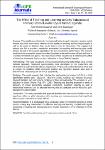| dc.description.abstract | Purpose: The significance of school environmental factors to girls’ education remains central because they have tremendous influence in the quality of teaching and learning of pupils as well as the extent of attention they pay to lessons when in classrooms. This suggests that schools that fail to provide a conducive atmosphere for teaching and learning may hardly achieve the best in their pupils especially in the area of academic performance. This scenario continues to be among the reasons for wider disparities in the performance of girls and boys in a number of Districts in Uganda. The main thrust of this research was to determine the effect of school environmental factors on girls’ education in Oyam District, Uganda. Methodology: The study was guided by the cross-sectional survey study design using a mixed methods approach. Structured questionnaires were developed by the researchers and administered to 139 randomly-selected respondents. Means and standard deviations were used to analyse the variables while correlation analysis and regression analysis were used to determine the relationship and the effect respectively.
Findings: The results revealed that only teaching and learning processes (p<0.01,𝛽=0.36) significantly predict girls’ education. However jointly, teaching and learning processes, physical facilities, and instructional facilities explain approximately 21% variation in girls’ education in Oyam District (Adj. R2= 0.205). Teaching and learning processes in terms of adequacy of lesson preparation, adequate assessment, classroom capacity as well as instructional materials such as adequate learning aids and adequate science kits affect girls’ education in Oyam District.
Conclusion: The study concluded that physical facilities and instructional facilities have no significant effect on girls’ education while teaching and learning processes had significant effect on girls’ education in Oyam District.
Recommendation: It is encouraged that a conducive school environment becomes a central concern among key stakeholders for effective teaching and learning coupled with regular monitoring of teaching and learning processes if girls’ education is to be enhanced in Oyam District. | en_US |

